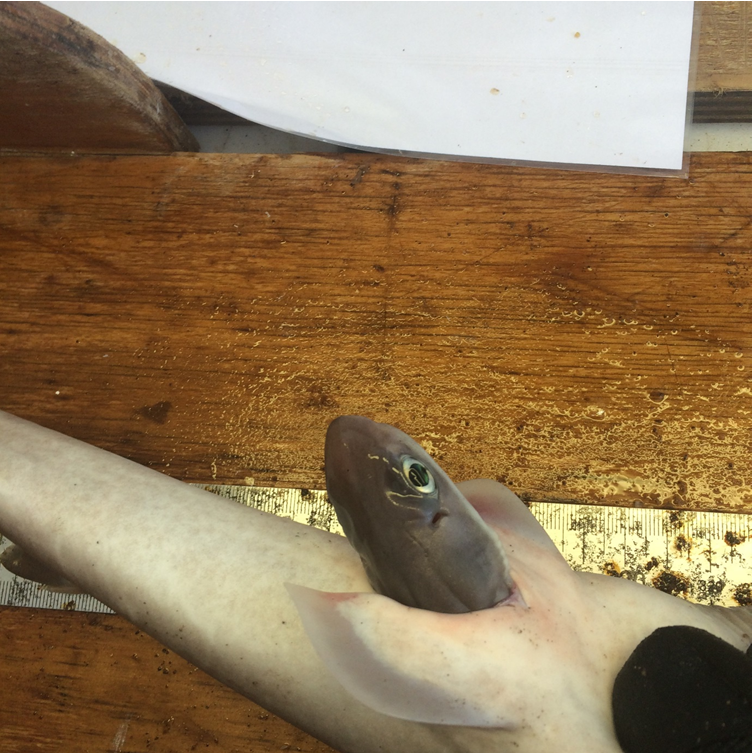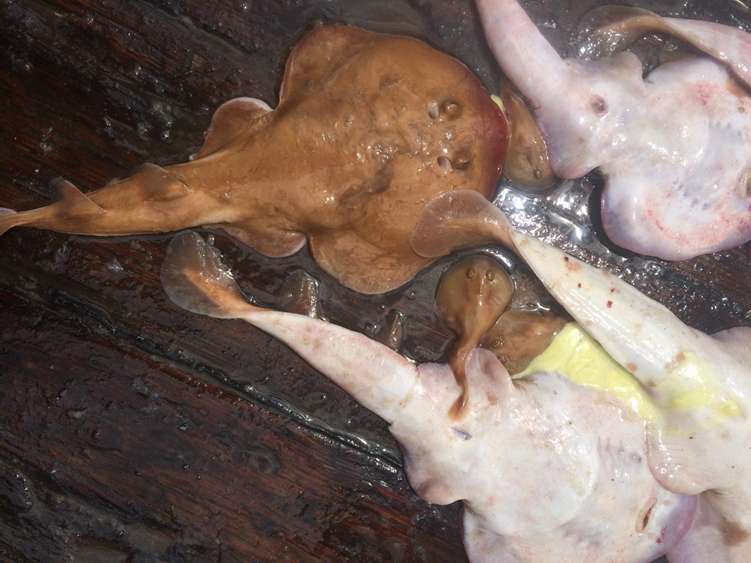- Female sharks and rays are more susceptible to aborting their young after being captured than previously realized, according to a recent review of scientific literature.
- The review found that 88 species that bear live young were susceptible. Among a subset of those species for which adequate data was available, researchers estimated that an average of 24 percent of pregnant females abort their offspring when captured.
- The authors argue that the phenomenon may be responsible for lost generations of threatened species.
- However, outside researchers consulted for this story say that the killing of adult sharks poses a much bigger threat to species survival.
Scientists have long raised concerns over the future of sharks and rays, of which some 100 million are caught and killed on fishing boats every year. They have paid somewhat less attention, however, to the animals that survive being hauled from the water and tossed back — and which are more susceptible to aborting their young after being captured than previously thought, according to a paper published this month in the journal Biological Conservation.
“Capture-induced parturition” (CIP) was the term the researchers settled on to describe the phenomenon, which they believe may be throttling already-declining populations. They sifted through academic papers detailing encounters with elasmobranchs, a group that includes sharks, rays, skates and sawfish, which have cartilage skeletons instead of bone, and large, buoyant livers in place of swim bladders. They were surprised by the frequency of casual references to sharks and rays aborting while caught, with the first account dating to 1810, and by the absence of any research looking directly at the phenomenon.
In all, they found 139 reports of CIP in 88 species that bear live young. Twenty-six of those reports contained enough data for the team to estimate the prevalence of CIP in 24 species. For those species, they found that between 2 and 85 percent of pregnant females lose their offspring through the stress of entanglement in nets or ensnarement on lines, for a cross-species average of 24 percent.
Kye Adams, lead author of the paper and a doctoral student at the University of Wollongong in Australia, warns that subsequent generations of some species may continue to decline even if direct killing were to be halted. “The 88 species represent a broad range from those that are of least concern for conservation up to some that are critically endangered,” he said.
The paper notes that few if any evaluations of shark and ray populations currently account for the loss of pups to CIP or the consequences this could have for populations. It assumes that most prematurely birthed sharks die.
“It is possible that this generational mortality could be having an underestimated impact on discarded species with otherwise high survival after release,” Adams said. He and his fellow researchers argue that more studies should investigate the long-term effects of CIP and its prevalence in commercial fishing.
Most elasmobranchs are particularly vulnerable to overfishing because they tend to mature late and invest a lot of energy in a small number of offspring. Many species have particularly long gestation periods — the spiny dogfish (Squalus acanthias) carries its pups for 22 months, for example — while others give birth only once every two years. All this makes elasmobranchs among the slowest organisms to recover from population declines.
The researchers think CIP is an evolved stress mechanism, either to distract potential predators or to allow pups to escape the mother’s death.


The team also searched social media for evidence of CIP in posts by recreational fishers.
“There are lots of videos online where people have caught a shark or ray, brought it onto land and it begins premature birth or aborting its litter and it is then kept on land for a long time, often with someone forcibly pulling out pups,” said Lachlan Fetterplace, Adams’s coauthor and fellow researcher at the University of Wollongong.
Many of the fishers are well-meaning and even claim to be assisting with the pups’ delivery, failing to realize the animal is undergoing CIP because of the stress of being captured, Fetterplace said. “The best thing to do is return the animal to the water as quickly as possible,” he added.
Besides fishing, the paper notes that research on elasmobranchs is a source of CIP, as many experiments on sharks and rays involve capturing individuals, tagging them with a sensor to track their movements and releasing them.

Nicholas Dulvy, a professor of marine biodiversity and conservation at Simon Fraser University in Canada, said he believes the issue of CIP is small fry compared to the slaughter of adult sharks.
“Killing breeding adults is the more serious issue … from an extinction risk and fisheries sustainability perspective,” said Dulvy, who co-chairs the Shark Specialist Group of the International Union for Conservation of Nature and Natural Resources.
He added that most sharks and rays that reach full term and are born under normal circumstances die before breeding anyway. “Hence, [newborns] contribute little to population growth rate, except in the least fecund sharks and rays such as manta and devil rays,” he said.
Kim Friedman, a senior fishery resources officer at the Food and Agriculture Organization of the United Nations, agreed that the severest impacts to elasmobranchs from fishing arise from the death of adults and was cautious as to whether CIP could be depleting shark and ray populations.
“This might not have a huge effect on population growth rate … but that of course will be species dependent,” he said, suggesting that prolific breeders such as the blue shark (Prionace glauca) may be entirely unaffected.
The new paper argues that humans can alleviate stress and injury to sharks and rays caught in fishing equipment by keeping them in the water and carefully cutting the line or net around any that are entangled. Friedman agreed that enforcing best practices in terms of “release strategies that promote live release” on fishing boats could help counter both unintended deaths of adults and losses from CIP. But he noted that for now there is no way to know how well fishers adhere to these principles.
“This area of rapidly changing practice — improved release of sharks and rays — has no dedicated programs of compliance measurement that are done systematically at present,” he said.
Amid uncertainty over how the most vulnerable elasmobranch species are coping with human pressures, study author Adams advocates for caution and further research.
“Conservation wise, the biggest chance we can give endangered species that abort when fished is to limit activity in areas that are important nursery grounds,” he said.
CITATIONS
Adams, K.R., Fetterplace, L.C., Davis, A.R., Taylor, M.D., & Knott, N.A. (2018). Sharks, rays and abortion: The prevalence of capture-induced parturition in elasmobranchs. Biological Conservation 217: 11-27.
Banner image: A type of electric ray, the Tasmanian numbfish (Narcine tasmaniensis), with one of its aborted embryos. Photo by Lachlan Fetterplace.
